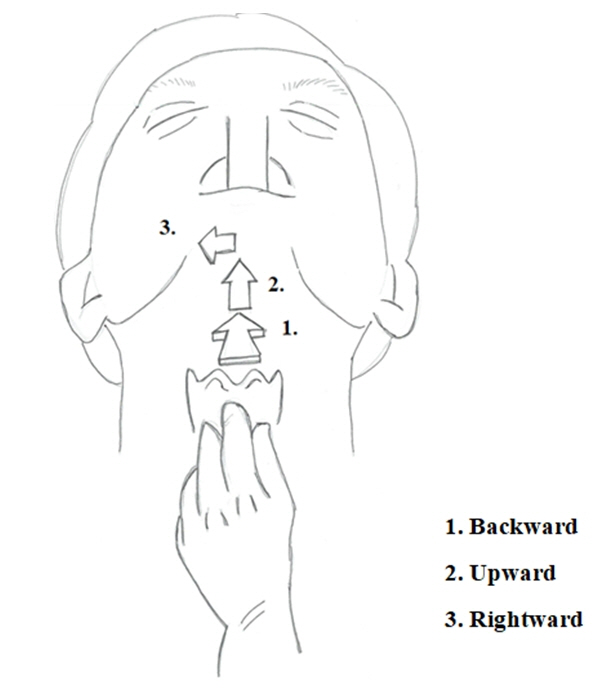Anesth Pain Med.
2021 Oct;16(4):391-397. 10.17085/apm.21026.
The effects of backward, upward, rightward pressure maneuver for intubation using the OptiscopeTM: a retrospective study
- Affiliations
-
- 1Department of Anesthesiology and Pain Medicine, Seoul Medical Center, Seoul, Korea
- KMID: 2524453
- DOI: http://doi.org/10.17085/apm.21026
Abstract
- Background
The OptiscopeTM and the backward, upward, rightward pressure (BURP) maneuver are widely used in clinical practice because the BURP maneuver facilitates intubation by improving visualization of the larynx. However, the effect of the BURP maneuver is unclear when using the OptiscopeTM. Therefore, we retrospectively investigated the effect of the BURP maneuver on intubation using the OptiscopeTM.
Methods
Sixty-eight patients intubated with the OptiscopeTM were enrolled. We used the BURP maneuver in Group A (n = 33) and the conventional maneuver (which does not use the BURP maneuver) in Group B (n = 35). BURP application status was a binary variable representing whether the BURP maneuver was used during the intubation. A multiple linear regression analysis was performed to assess the effects of the BURP application status on intubation time controlling for body mass index, preoperative dental injury status, obstructive sleep apnea history, thyromental distance, sternomental distance (SMD), interincisor distance, history of neck rotation restriction, and Mallampati classification.
Results
There was no difference in the intubation time between the two groups. According to the regression model (R2 = 0.308, P = 0.007), the BURP maneuver (Group A) decreased the intubation time by 6.089 seconds (95% confidence interval 1.303–10.875, P = 0.014) compared to Group B.
Conclusion
The BURP maneuver reduced intubation time when using the OptiscopeTM.
Figure
Reference
-
1. Ko DD, Kang H, Yang SY, Shin HY, Baek CW, Jung YH, et al. A comparison of hemodynamic changes after endotracheal intubation by the Optiscope™ and the conventional laryngoscope. Korean J Anesthesiol. 2012; 63:130–5.2. Nam K, Lee Y, Park HP, Chung J, Yoon HK, Kim TK. Cervical spine motion during tracheal intubation using an Optiscope versus the McGrath videolaryngoscope in patients with simulated cervical immobilization: a prospective randomized crossover study. Anesth Analg. 2019; 129:1666–72.3. Yoon HK, Lee HC, Park JB, Oh H, Park HP. McGrath MAC videolaryngoscope versus Optiscope video stylet for tracheal intubation in patients with manual inline cervical stabilization: a randomized trial. Anesth Analg. 2020; 130:870–8.4. Oh H, Kim H, Yoon HK, Lee HC, Park HP. No radiographic index predicts difficult intubation using the Optiscope™ in cervical spine surgery patients: a retrospective study. BMC Anesthesiol. 2020; 20:47.5. Amir SH, Ali QE, Bansal S. A comparative evaluation of video stylet and flexible fibre-optic bronchoscope in the performance of intubation in adult patients. Indian J Anaesth. 2017; 61:321–5.6. Park SK, Yun SH, Park JC, Kim HJ. Learning curve of skilled anesthesiologists for endotracheal intubation using Optiscope™. Anesth Pain Med. 2017; 12:271–4.7. Knill RL. Difficult laryngoscopy made easy with a "BURP". Can J Anaesth. 1993; 40:279–82.8. Takahata O, Kubota M, Mamiya K, Akama Y, Nozaka T, Matsumoto H, et al. The efficacy of the "BURP" maneuver during a difficult laryngoscopy. Anesth Analg. 1997; 84:419–21.9. Yu T, Wu RR, Longhini F, Wang B, Wang MF, Yang FF, et al. The "BURP" maneuver improves the glottic view during laryngoscopy but remains a difficult procedure. J Int Med Res. 2020; 48:300060520925325.10. Seo H, Kim E, Son JD, Ji S, Min SW, Park HP. A prospective randomised study of a rigid video-stylet vs. conventional lightwand intubation in cervical spine-immobilised patients. Anaesthesia. 2016; 71:1341–6.11. Armstrong J, John J, Karsli C. A comparison between the GlideScope video laryngoscope and direct laryngoscope in paediatric patients with difficult airways - a pilot study. Anaesthesia. 2010; 65:353–7.12. Al Ramadhani S, Mohamed LA, Rocke DA, Gouws E. Sternomental distance as the sole predictor of difficult laryngoscopy in obstetric anaesthesia. Br J Anaesth. 1996; 77:312–6.13. Savva D. Prediction of difficult tracheal intubation. Br J Anaesth. 1994; 73:149–53.14. Prakash S, Mullick P, Bhandari S, Kumar A, Gogia AR, Singh R. Sternomental distance and sternomental displacement as predictors of difficult laryngoscopy and intubation in adult patients. Saudi J Anaesth. 2017; 11:273–8.15. Khan ZH, Mohammadi M, Rasouli MR, Farrokhnia F, Khan RH. The diagnostic value of the upper lip bite test combined with sternomental distance, thyromental distance, and interincisor distance for prediction of easy laryngoscopy and intubation: a prospective study. Anesth Analg. 2009; 109:822–4.16. Motheral B, Brooks J, Clark MA, Crown WH, Davey P, Hutchins D, et al. A checklist for retrospective database studies--report of the ISPOR Task Force on Retrospective Databases. Value Health. 2003; 6:90–7.17. Eichelsbacher C, Ilper H, Noppens R, Hinkelbein J, Loop T. [Rapid sequence induction and intubation in patients with risk of aspiration: recommendations for action for practical management of anesthesia]. Anaesthesist. 2018; 67:568–83. German.
- Full Text Links
- Actions
-
Cited
- CITED
-
- Close
- Share
- Similar articles
-
- A comparison of hemodynamic changes after endotracheal intubation by the Optiscope(TM) and the conventional laryngoscope
- The efficacy of OptiScope PM201 video system: comparison to conventional Macintosh laryngoscopic endotracheal intubation method
- “Spray-as-you-go†medical technique for awake intubation using a combination of an epidural catheter and the OptiScope in a patient with Ludwig's angina: A case report
- An Effects of Repeated Valsalva Maneuver on Circulation of Normal Men
- Sellick's Maneuver and Tracheal Bleeding by Mucosal Damage: A case report


